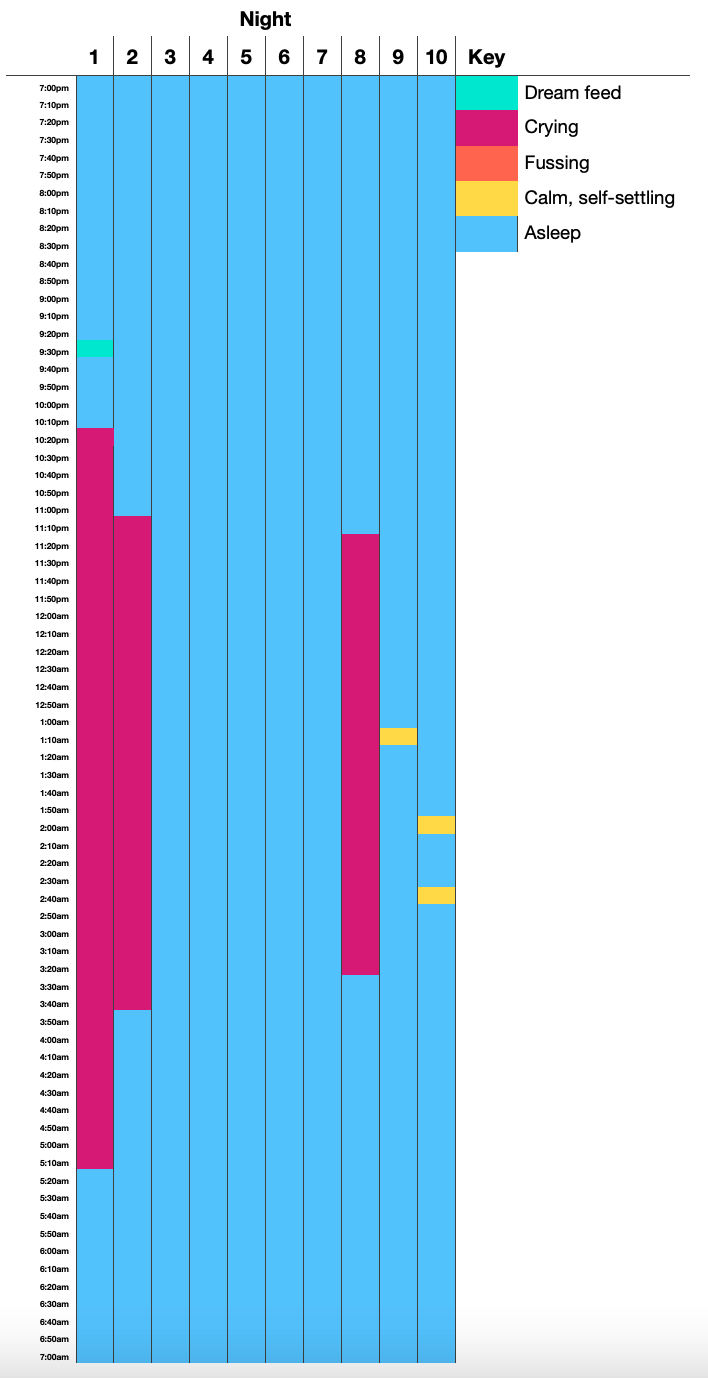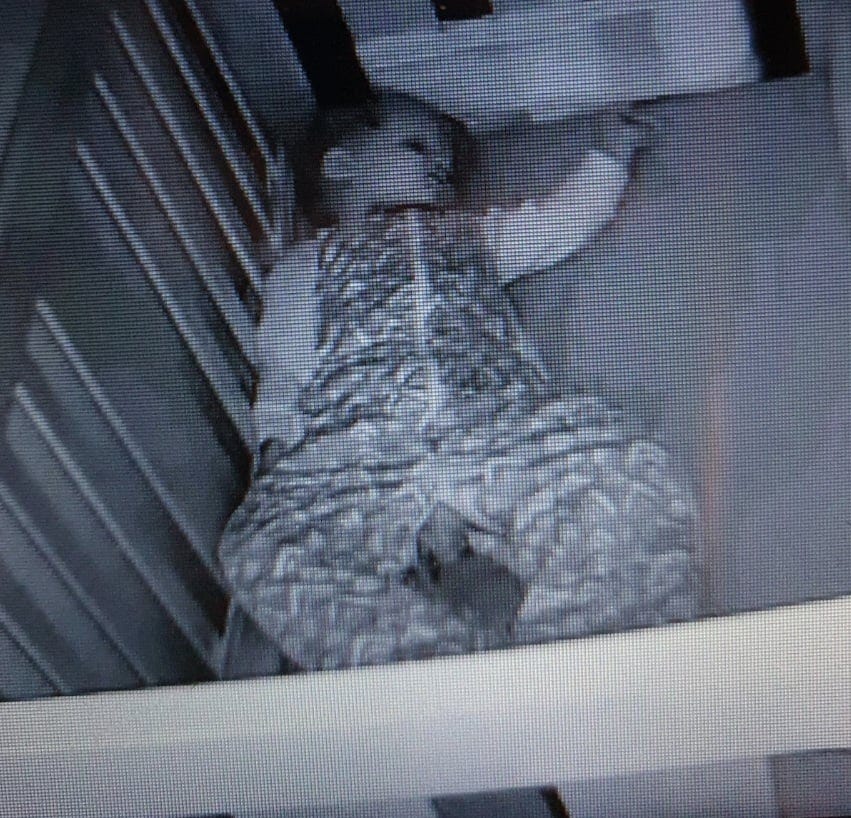Thursday, 26th of November, 2020. This is the date my (then) 8 month old daughter first. Slept. Through. The. Night. (Trust me, those four extra periods are warranted.)
Did we get there without tears, like I had hoped? No. Despite all my best efforts, we ended up sacrificing a few salty droplets on the altar of sleep. (Well, a lot of angst-ridden tears from me, and a few angry tears from my daughter.) But we did manage to avoid the traditional cry-it-out/Ferber method and found a kind of hybrid approach that I could stomach.
The winding road
In Part 1 of our sleep journey, I had been determined to find a “gentle” way to help my then 14 week old daughter learn how to sleep. I settled on a method that essentially involved me playing calm chicken with her, where I pulled the plug on it if ever she started to cry.
We started with naps. I saw an improvement in her sleep immediately, and 9 weeks later, my little one was falling asleep independently for naps and bedtime.
Naps themselves had become a dream - she would go down easy and stay asleep for at least an hour (the little champion). Where I once feared the very word “nap,” I had finally reached a point where I could reliably count on two blocks of decent time to myself each day. Bliss.
But nights were a different story.
Despite falling asleep independently at bedtime, my daughter continued to wake at least once overnight. She was still nursing during the night at that point. If she woke and it had been over 4-5 hours since she went down for the night, I would give her a feed. But for every other wakeup, I used the calm chicken method to try and settle her. Sometimes it worked. Sometimes it didn’t. If ever our game of calm chicken started to run a little long, I would shush-pat her right to sleep. Then I would slink back into my room and pray that the next time she woke, the sun would be up.
It had been weeks, and despite naps coming together beautifully, there was still no discernible improvement in her night wakings. There were nights of hope. And nights of despair. And no real trend up or down, as you can see below.
The graph shows how many times she woke each night and how they were handled. (The two-feed nights were the ones where we had often tried everything else, but at 4am when you’re attempting to settle your clean, dry and warm-but-not-too-warm baby for the sixth time and it isn’t working, all that seems left is boob. And although I’d like to think my breasts have superpowers, even that didn’t always work.)
I would like to say that I could have stuck it out if only I could have seen a trend - if only I could have seen that the night wakings were slowly beginning to decrease. But they weren’t. And worse still, the length of time it took to actually settle my daughter was increasing. Drastically. We even resorted to pulling her into bed with us once out of pure desperation for sleep, but all she did was climb gleefully all over us for three hours, babbling with delight. (She ironically only went back to sleep when we put her back in her crib.)
Babies develop at an alarming rate and it seems she was becoming wise to our game of calm chicken. And she was calling our bluff.
I started to dread the coming night, and the utterly broken sleep it would bring. My daughter was tired. My husband was tired. I was tired. We were all zombies.
Something needed to change.
A new approach
Baby Sleep is such a beast. I have never read, experimented or cried more about a subject in my entire life. (And I studied engineering at uni!)
I was well aware of differences between the Ferber check-in method and the cold-turkey cry-it-out method, yet I knew both methods still involved leaving your little one to cry (often scream) for a period of time, which I had been trying to avoid for eight months. I even bought the Taking Cara Babies and Little Z sleep courses out of desperation, and was dismayed to find they were simply variations of Ferber. Was there no way to teach my daughter how to connect sleep cycles at night other than to leave her scream for clinically lengthening intervals of time?
In the end, I devised a method that was a little closer to the calm-chicken end of the sleep training spectrum than Ferber (“Cherber?”). It involved check-ins along with a slight modification to our night nursing arrangement.
1) Checkins
To those who aren't aware, the Ferber method basically involves “checking in” on your protesting baby at increasing intervals of time until they fall asleep. A check-in is where you quietly go into your baby’s room and verbally reassure them, then leave the room. The idea is that, instead of helping them fall asleep, they learn to do it themselves (with periodic reassurance/cheerleading from Mum or Dad).
Let me tell you, those crisp and matter-of-fact five lines do not do the slightest bit of justice to what it actually feels like to go through such a process. And I followed a watered down version!
Basically, I knew I wasn’t capable of handling Ferber straight up, so I added my own… mixers… to dilute its potency.
These were my modifications:
To hell with the increasing intervals of time. I decided three minutes was the absolute longest I could bear to hear her protests. If she screamed for three minutes straight, I would go in and reassure her, no matter how many times it happened.
To hell with the interval of time itself. I promised myself (and my daughter) that I would go in even sooner if I felt she needed my presence.
To hell with verbal reassurance only (as some Ferber implementations advise). My version of “reassurance” would involve physically and verbally calming her first, even if it meant pulling her right out of the crib and into my arms. Then, as soon as she was back in the crib and calm, I would whisper, “You’ve got this, baby. I’m right here with you, every step of the way. I love you so much,” before leaving the room.
2) Dream feed
Up until this point, when my daughter did feed at night, it was usually only for around 3-5 minutes. She couldn’t have been getting more than a couple of ounces. Our paediatrician had strongly suggested that our big healthy 95th-percentile baby was more than capable of lasting the night without a feed. This thought horrified me, and filled my head with visions of a ravenous, starving baby waking at 4am, livid with hunger. (Fortunately, that vision did not come true.)
So as part of this Cherber cocktail, I also decided to switch from reactive to proactive nursing during the night by trying a “dream feed” at around 10pm before I went to bed.
“Dream feed” is such a cute phrase. But it’s really just a nice way of saying, “Instead of you waking me for a feed, I'm going to sneak in and offer you one while you’re sleeping and hope that you get what you need from me without waking up too much.” I figured this change could only improve our night wakings problem, as my poor daughter was probably confused by the fact that sometimes her night wakings were answered with a nipple, and other times with butt pats in her crib.
Summary of the plan
Offer a dream feed at 10pm.
Address any night protests by:
Starting a timer for 3 minutes.
Go in and briefly calm baby in crib (or out of crib in arms, if necessary), at the sooner of:
The timer running out, OR
The moment screams reach levels that make every cell in body want to go to baby - whichever comes first.
As soon as baby is calm and in the crib, softly reassure them (“You’ve got this, baby. I’m right here with you, every step of the way. I love you so much.”) and leave the room.
I knew that there was a strong possibility my proposed modifications might work against me and make our sleep problems even worse. Many sleep training blogs stress the importance of consistency, and you could argue my variable presence might be verging on inconsistent. (Their infamous, “If I cry longer and harder, mummy will eventually come,” warning flashed like a neon sign in my mind.) But this method was already pushing me to limits, and it was all I had. So I bravely (stupidly?) decided to give it a try.
Sweet dreams
As usual when it comes to baby sleep, my daughter surprised me - in a good way.
My husband and I had committed to two weeks of the Cherber method and braced ourselves for a fortnight of fried nerves and salty tears.
This is what actually happened.
All that blue you see there is my baby sleeping peacefully in her crib.
Those tiny little red blips are my daughter angrily screaming out for me, beyond pissed off that she wasn’t being given the usual help to go back to sleep. She never did cry out like that for more than a minute or two straight, and any check-ins I did were usually because I felt compelled to go to her sooner.
Mind you, psychologically, this is what it felt like happened.
(Be prepared for some major time dilation if you attempt this method! One minute in Screaming Angry Baby Land feels like hours.)
But now that I look at the data in the cold light of day (a day that comes after a solid eight hours of uninterrupted sleep!) I can see that it was relatively angst-free.
Night 1
On our first night of Cherber, my daughter blessedly accepted the dream feed without properly waking, nursed for a few minutes, and didn’t make a peep when I transferred her back to her crib. One hurdle down.
Then the true test began.
She woke twice during the night - first at around midnight and then again about an hour later. The first wake-up “session” lasted 12 minutes, total. She wasn’t immediately angry, but after a couple of minutes she realised something was different and started to escalate. I ended up doing two check-ins, both according to my gut and not the timer.
What I found interesting (after the fact) was that she didn’t rage in her crib for the full 12 minutes. Rather, it seemed to come in waves. There were moments of quiet and peace, almost like she was trying to fall asleep by herself but continuing to get stuck at a certain point. (That would make me mad as hell too!) It was in those furious moments that I rushed to her side. I picked her up, stroked her hair, hugged her tight and mentally tried to absorb all of her frustration and anger into me - to carry that burden for her. Once she was calm, I carefully placed her in the crib and whispered my words of comfort while quietly willing all of my strength into her through my palm, pressed against her lower back. Then, I left the room.
Fortunately, despite the warnings I had read, my frequent check-ins didn’t seem to prolong her anger. She did let out a shriek that rattled the walls as soon as I left the room, but she miraculously often quietened almost instantly after that, as if she understood the words I had whispered in her ear - that I was there, rooting for her every step of the way and hadn’t abandoned her. (This is what I like to think, anyway.)
And astonishingly, after only 12 relatively painless minutes (total), she fell asleep all on her own. In the middle of the night!
…
And stayed asleep for forty minutes.
Her second wake-up “session” of the night was a bit longer than the first and she took 46 minutes to finally get back to (and stay) asleep. In this session, I ended up doing 5 check-ins. And again, all were done before the timer ran out. I simply felt compelled to go to her in those moments and offer that reassurance.
There were some periods there where she seemed to have fallen asleep and was still and quiet for even as long as 10 minutes. (The hope that resides in your heart in these moments is so intense. “Please, please, please, let her be asleep!”) But then she would wake and begin escalating again. Let me tell you, those 46 minutes felt like hours.
But at the end of it, the vision before us on the baby monitor was that of a peacefully sleeping cherub. A cherub that stayed asleep until after 7am in the morning!
Night 2
My husband and I went to bed on the second night of our dalliance with Cherber not quite knowing what to expect, and daring to hope.
When I snuck into my daughter’s room to offer her a dream feed at 10pm, she actually refused! At a bit of a loss, I transferred her barely conscious sleeping form back to the crib and slunk out of the room.
She next woke at around 12:30am. In contrast with the wake-ups from the previous night, she didn’t immediately start fussing (nor screaming). Instead, she was largely quiet for a good 30 minutes as she calmly worked through her own process of self-settling. Seemingly exasperated, she started fussing at around 1am and we began using the timer not long after that. I ended up doing two gut-driven check-ins (before the timer ran out) and 54 minutes after she first woke, she was peacefully asleep.
The next time she woke it was 7.15am in the morning. And she woke happy! Refreshed. Smiling. Excited to start the day. I was gobsmacked.
Night 3
On our third night of Cherber, I bravely forewent the dream feed. (Remembering how peacefully she was sleeping last night when I offered the feed, I just didn’t have the heart to wake her this time.)
Little did we know it, but my husband and I were about to sleep through the night for the first time in 8 months. Because our daughter was about to sleep through the night for the first time in 8 months.
Nights 4-7
She slept right through the next night - all 12 hours of it! And the night after that. And again. And again! For four nights straight, we kissed our calm and sleepy daughter goodnight in her crib at 7pm and collected our calm and smiling daughter from her crib at 7am, without a single peep from the monitor during the night. I couldn’t believe it.
Night 8
Ah, the good old extinction burst. I had read about this fabled creature. And I finally got a chance to see the ugly beast. (I kid, I kid.)
My daughter’s extinction burst was actually more like an extinction fizzle. She woke at 12:30am and rapidly escalated to angry screaming. I rushed in to check on her, pulled her out of the crib and comforted her in my arms. When I put her back down, reassured her and left the room, she let out an angry scream that seemed almost… perfunctory. Then she rolled over, sucked her thumb and went right back to sleep. The whole ordeal lasted less than 20 minutes. The next time she woke, sunlight was streaming in through our windows and she was sitting happily in her crib, eagerly awaiting her day of adventure to start.
Nights 9 and 10
The next two nights she woke around that usual “sticky” time of 12:30am, mildly fussed for all of 30 seconds, and then went right back to sleep!
And that was it! She started sleeping through the night from then on.
Calm chicken vs Cherber
I do think that there is a general sweet spot regarding age for which the gentle method will work, and that it’s probably in the 4-7 months old range. Anything beyond that, and they seem to really quickly wisen up to what is happening.
And I sometimes wonder whether the “calm chicken” gentler method might have worked for nights as well if I had simply switched from reactive to proactive nursing during the night. My old professor would have frowned upon me were this a proper experiment as I changed two variables simultaneously: dropping night feeds and how we responded to her night wakings. It’s hard to know which one had more of an impact on the final outcome.
I guess I’ll never know.
To be honest though, the scientist in me really doesn’t care because my daughter isn’t an experiment. The mother in me is just happy that her daughter is finally getting a good stretch of 12 hours of unbroken sleep every night!
Here’s to the Cherber cocktail.








I have so many questions ! But my biggest one: what if she is NEVER calm in her crib? Like the second she touches it she screams blue murder.